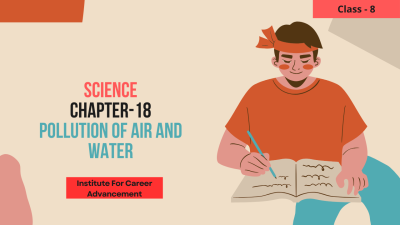Pollution Of Air And Water - Class 8
Life occurs in the region where the three components of life earth i.e., land or lithosphere, water or hydrosphere and air or atmosphere interact. Parts of the earth which support life together constitute biosphere. Human beings are the only organisms who try to manipulate the environment to fulfil their needs and comforts [food, shelter, clothing's, transport etc.]. Increase in human population and great advancement in industry and technology, in the recent past have damaged the balanced and healthy environment. The imbalance in the environment has given rise to various environmental problems and majority of them are related to air, water and soil pollution. জীবন এমন অঞ্চলে ঘটে যেখানে জীবনের তিনটি উপাদান পৃথিবী i.e., ভূমি বা লিথোস্ফিয়ার, জল বা হাইড্রোস্ফিয়ার এবং বায়ু বা বায়ুমণ্ডল ইন্টারঅ্যাক্ট করে। পৃথিবীর যে অংশগুলি একসঙ্গে জীবনকে সমর্থন করে সেগুলি জীবমণ্ডল গঠন করে। মানুষই একমাত্র জীব যারা তাদের চাহিদা এবং স্বাচ্ছন্দ্য [খাদ্য, আশ্রয়, পোশাক, পরিবহন ইত্যাদি] পূরণের জন্য পরিবেশকে নিয়ন্ত্রণ করার চেষ্টা করে। ]। সাম্প্রতিক অতীতে মানুষের জনসংখ্যা বৃদ্ধি এবং শিল্প ও প্রযুক্তিতে ব্যাপক অগ্রগতি ভারসাম্যপূর্ণ ও স্বাস্থ্যকর পরিবেশকে ক্ষতিগ্রস্ত করেছে। পরিবেশের ভারসাম্যহীনতা বিভিন্ন পরিবেশগত সমস্যার জন্ম দিয়েছে এবং এর বেশিরভাগই বায়ু, জল এবং মাটি দূষণের সাথে সম্পর্কিত।
English
Last updated
Wed, 27-Nov-2024



















